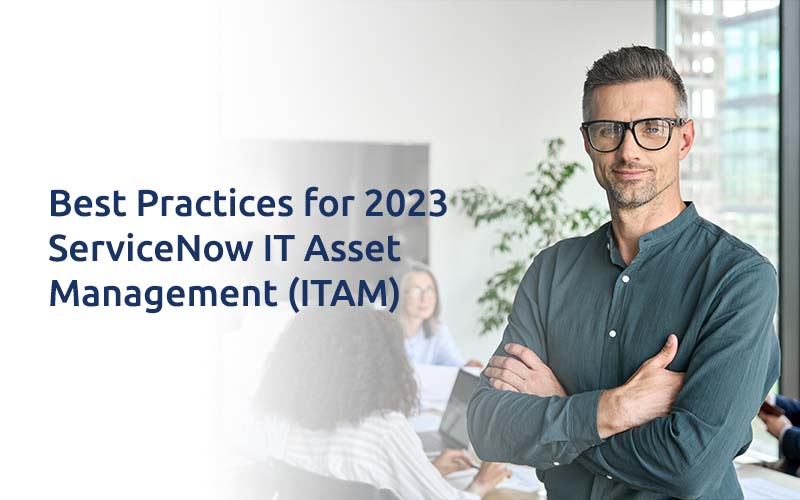Best Practices for 2023 ServiceNow IT Asset Management (ITAM)
Technology has become so pervasive in business operations that it is now practically required. Individual devices to entire networks can be considered IT assets. Because there are usually a plethora of different IT assets, the methodology of IT Asset Management has become highly significant.
ServiceNow IT Asset Management (ITAM):
IT Asset Management (ITAM) by ServiceNow automates the entire IT lifecycle on a single platform. Assets have a finite lifespan, and through ITAM and proactive management, an organization can maximize their value. Common life-cycle phases include planning, procurement, deployment, maintenance, retirement, and disposal.
IT Asset Management Types:
Software: Because it involves compliance requirements, licensing, shadow IT, and IoT, this type of ITAM is a little more complicated than the others. Software assets must be monitored and reviewed on a regular basis, and they must be adaptable enough to meet standards, make provisions, and adapt to a changing market.
Equipment is also essential in an organization’s IT ecosystem. Physical assets include PCs, printers, copiers, laptops, portable devices, data centers, and any other equipment used for data management within the organization.
Benefits of ServiceNow IT Asset Management:
Being Organized:
A lack of organization is one of the first issues that ServiceNow ITAM addresses. ITAM allows you to keep track of and manage all of your IT assets. Keeping track of all IT assets can be difficult, but an ITAM process simplifies this by providing a designated location to organize these assets.
Improved Security:
Another significant advantage of ITAM is that it gives you greater control over the security of your IT environment. IT assets inherently carry security risks, which should be minimized wherever possible. ITAM provides you with greater visibility into your IT assets, allowing you to track their health, status, and security.
Cost Optimization:
IT assets are expensive in any organization, and failing to track these assets can result in significant financial loss. Hardware, software licenses, and maintenance costs can quickly add up if you don’t keep track of them. Using a practical and well-thought-out ITAM process will help you manage your devices’ health, status, and maintenance, reducing costs associated with poor asset tracking.
Disposal and Waste Management:
Appropriate IT asset management can also assist your organization in reducing waste associated with the removal of these assets. Devices do not last forever, but proper maintenance significantly increases their lifespan. Your company can also ensure that when gadgets reach their end of life, they are disposed of in a responsible manner.
Best Practices for 2023 ServiceNow IT Asset Management (ITAM)
ITAM is a valuable addition to any company that has IT assets. Here are seven best practices in IT Asset Management to consider when implementing ITAM in your organization:
Continuous Process:
ITAM is a process, not something you do once and then forget about. ITAM will benefit your company even more as you work to improve the process on a regular basis.
Update and monitor your IT assets on a regular basis to ensure that your ITAM process is always up to date and ready to use. This ensures that when assets require management, you already have a process in place to handle the issue.
Continuous Monitoring:
Ensure that any new devices introduced within the company are added to your IT asset inventory. You should also install monitoring software on each new asset you acquire as soon as possible so that you have immediate visibility into the device.
Keep track of newly acquired IT assets and ensure they are actively monitored from the start. It will ensure the accuracy and smooth operation of your ITAM process.
Automation:
Few things will make the ITAM process easier or more efficient than automating key actions. Automated tasks and to-dos are equivalent to having a team that works around the clock to ensure that things are completed on time.
Automation can be used for periodic scheduled scans and automatic alerts, allowing you to be aware of all assets at the same time because the work of checking is done for you automatically. ITAM uses automated checks to identify assets that require assistance and deploy management agents to resolve any issues.
Continuous Tracking:
Because IT environments are complex, all IT assets must be actively monitored. ITAM is an efficient way to track your IT assets in real time and can help you gain greater control and management over your environment. Connect ITAM to an RMM or endpoint management tool to automatically manage and update newly tracked assets to get the most out of it.
Prioritizing Assets:
With so many IT assets within an organization, determining which ones to focus on first can be difficult. Some IT devices may only be used by one person in the company, whereas another IT asset may be critical to the overall operations of the company. Sort your IT assets according to their importance to business operations. This allows you to make faster decisions if more than one device requires maintenance at the same time. The ability to prioritize the importance of specific assets also helps to maintain business uptime.
Lifecycle Management:
Asset life cycles are critical in ITAM because they help organizations determine how long an asset will work reliably and when it should be disposed of. A lifecycle approach enables you to get the most out of your assets over their entire lifespan.
Implement ServiceNow IT Asset Management (ITAM) in Your Organization
ServiceNow ITAM is critical for optimizing internal business processes. By following these ITAM best practices for successful technology management, you will reap its many benefits and contribute to your organization’s asset management success. DxSherpa offers ServiceNow IT Asset Management that provides real-time updates on all of your assets.
ServiceNow, the ServiceNow logo, Now, Now Platform, and other ServiceNow marks are trademarks and/or registered trademarks of ServiceNow, Inc. in the United States and/or other countries.
